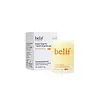What's inside
What's inside
 Key Ingredients
Key Ingredients

 Benefits
Benefits

 Concerns
Concerns

 Ingredients Side-by-side
Ingredients Side-by-side

Diisostearyl Malate
EmollientPhytosteryl/Isostearyl/Cetyl/Stearyl/Behenyl Dimer Dilinoleate
Skin ConditioningBis-Diglyceryl Polyacyladipate-2
EmollientTriethylhexanoin
MaskingMicrocrystalline Wax
Emulsion StabilisingHydrogenated Polyisobutene
EmollientDipentaerythrityl Hexahydroxystearate/Hexastearate/Hexarosinate
Skin ConditioningWater
Skin ConditioningSilica Dimethyl Silylate
Emollient1,2-Hexanediol
Skin ConditioningGlycerin
HumectantSorbitan Stearate
EmulsifyingCedrol
EmollientDimethicone
EmollientHelianthus Annuus Seed Oil
EmollientGluconolactone
Skin ConditioningMaltodextrin
AbsorbentButylene Glycol
HumectantProtease
ExfoliatingNiacinamide
SmoothingTocopherol
AntioxidantAscorbic Acid
AntioxidantCyanocobalamin
Skin ConditioningSerine
MaskingGlycine Soja Oil
EmollientSodium Citrate
BufferingBeta-Carotene
Skin ConditioningDaucus Carota Sativa Root Extract
Skin ConditioningDaucus Carota Sativa Seed Oil
EmollientCholesterol
EmollientHydrogenated Lecithin
EmulsifyingButyrospermum Parkii Butter
Skin ConditioningCitric Acid
BufferingSqualane
EmollientGlyceryl Glucoside
HumectantAlcohol Denat.
AntimicrobialBHT
AntioxidantCetearyl Alcohol
EmollientAvena Sativa Kernel Extract
AbrasiveCalendula Officinalis Flower Extract
MaskingNepeta Cataria Extract
TonicRubus Idaeus Leaf Extract
Skin ConditioningBaptisia Tinctoria Root Extract
Skin ConditioningStellaria Media Extract
Skin ConditioningStearic Acid
CleansingAcetyl Tetrapeptide-9
Skin ConditioningCeramide NP
Skin ConditioningCaprylyl Glycol
EmollientCeramide Ns
Skin ConditioningPhytosphingosine
Skin ConditioningAcetyl Hexapeptide-8
HumectantCeramide AP
Skin ConditioningCeramide As
Skin ConditioningDesamido Collagen
Skin ConditioningCeramide EOP
Skin ConditioningCitrus Aurantium Dulcis Peel Oil
MaskingCitrus Aurantifolia Oil
CleansingPelargonium Graveolens Flower Oil
MaskingRosmarinus Officinalis Leaf Oil
MaskingLimonene
PerfumingCitronellol
PerfumingGeraniol
PerfumingCitral
PerfumingLinalool
PerfumingDiisostearyl Malate, Phytosteryl/Isostearyl/Cetyl/Stearyl/Behenyl Dimer Dilinoleate, Bis-Diglyceryl Polyacyladipate-2, Triethylhexanoin, Microcrystalline Wax, Hydrogenated Polyisobutene, Dipentaerythrityl Hexahydroxystearate/Hexastearate/Hexarosinate, Water, Silica Dimethyl Silylate, 1,2-Hexanediol, Glycerin, Sorbitan Stearate, Cedrol, Dimethicone, Helianthus Annuus Seed Oil, Gluconolactone, Maltodextrin, Butylene Glycol, Protease, Niacinamide, Tocopherol, Ascorbic Acid, Cyanocobalamin, Serine, Glycine Soja Oil, Sodium Citrate, Beta-Carotene, Daucus Carota Sativa Root Extract, Daucus Carota Sativa Seed Oil, Cholesterol, Hydrogenated Lecithin, Butyrospermum Parkii Butter, Citric Acid, Squalane, Glyceryl Glucoside, Alcohol Denat., BHT, Cetearyl Alcohol, Avena Sativa Kernel Extract, Calendula Officinalis Flower Extract, Nepeta Cataria Extract, Rubus Idaeus Leaf Extract, Baptisia Tinctoria Root Extract, Stellaria Media Extract, Stearic Acid, Acetyl Tetrapeptide-9, Ceramide NP, Caprylyl Glycol, Ceramide Ns, Phytosphingosine, Acetyl Hexapeptide-8, Ceramide AP, Ceramide As, Desamido Collagen, Ceramide EOP, Citrus Aurantium Dulcis Peel Oil, Citrus Aurantifolia Oil, Pelargonium Graveolens Flower Oil, Rosmarinus Officinalis Leaf Oil, Limonene, Citronellol, Geraniol, Citral, Linalool
Water
Skin ConditioningGlycerin
HumectantChondrus Crispus Powder
AbrasiveCeratonia Siliqua Gum
EmollientXanthan Gum
EmulsifyingPhenoxyethanol
PreservativeAllantoin
Skin ConditioningChlorphenesin
AntimicrobialParfum
MaskingVaccinium Angustifolium Fruit Extract
Skin ProtectingAgar
MaskingAdenosine
Skin ConditioningCalcium Lactate
AstringentPotassium Chloride
Glucose
HumectantTocopheryl Acetate
AntioxidantDisodium EDTA
Honey Extract
HumectantSodium Hyaluronate
HumectantMaltodextrin
AbsorbentHydrolyzed Collagen
EmollientPrunus Armeniaca Kernel Oil
MaskingCI 77492
Cosmetic ColorantPrunus Persica Fruit Extract
AbrasiveCamellia Japonica Flower Water
Skin ConditioningCyamopsis Tetragonoloba Gum
Emulsion StabilisingPEG-60 Hydrogenated Castor Oil
EmulsifyingBeta-Glucan
Skin ConditioningSea Water
HumectantMentha Piperita Leaf Water
Skin ConditioningCucumis Sativus Fruit Extract
EmollientSalicylic Acid
MaskingPropanediol
SolventCitric Acid
BufferingIron Oxides
Rubus Idaeus Fruit Extract
AstringentCocos Nucifera Fruit Extract
EmollientEthylhexylglycerin
Skin ConditioningPunica Granatum Extract
AstringentCitrus Limon Peel
MaskingHydrogenated Polyisobutene
EmollientNiacinamide
SmoothingAloe Barbadensis Leaf Juice Powder
Skin ConditioningOenothera Biennis Oil
EmollientCarica Papaya Fruit Extract
Skin ConditioningMica
Cosmetic ColorantSodium Acetylated Hyaluronate
HumectantChondrus Crispus
MaskingHydrolyzed Hyaluronic Acid
HumectantButylene Glycol
HumectantGlycine Soja Oil
EmollientAcetyl Hexapeptide-8
HumectantCentella Asiatica Extract
CleansingCI 77007
Cosmetic ColorantAloe Ferox Leaf Juice Powder
Skin ConditioningHydrogenated Lecithin
EmulsifyingSimmondsia Chinensis Seed Extract
AbrasiveSimmondsia Chinensis Seed Oil
EmollientOryza Sativa Extract
AbsorbentPunica Granatum Fruit Extract
AntioxidantMethyl Alcohol
SolventSodium Oleate
CleansingHamamelis Virginiana Extract
AntiseborrhoeicRicinus Communis Seed Oil
MaskingAnemarrhena Asphodeloides Root Extract
Skin ConditioningTitanium Dioxide
Cosmetic Colorant1,2-Hexanediol
Skin ConditioningCI 73360
Cosmetic ColorantArgania Spinosa Kernel Oil
EmollientPortulaca Oleracea Extract
Skin ConditioningWater, Glycerin, Chondrus Crispus Powder, Ceratonia Siliqua Gum, Xanthan Gum, Phenoxyethanol, Allantoin, Chlorphenesin, Parfum, Vaccinium Angustifolium Fruit Extract, Agar, Adenosine, Calcium Lactate, Potassium Chloride, Glucose, Tocopheryl Acetate, Disodium EDTA, Honey Extract, Sodium Hyaluronate, Maltodextrin, Hydrolyzed Collagen, Prunus Armeniaca Kernel Oil, CI 77492, Prunus Persica Fruit Extract, Camellia Japonica Flower Water, Cyamopsis Tetragonoloba Gum, PEG-60 Hydrogenated Castor Oil, Beta-Glucan, Sea Water, Mentha Piperita Leaf Water, Cucumis Sativus Fruit Extract, Salicylic Acid, Propanediol, Citric Acid, Iron Oxides, Rubus Idaeus Fruit Extract, Cocos Nucifera Fruit Extract, Ethylhexylglycerin, Punica Granatum Extract, Citrus Limon Peel, Hydrogenated Polyisobutene, Niacinamide, Aloe Barbadensis Leaf Juice Powder, Oenothera Biennis Oil, Carica Papaya Fruit Extract, Mica, Sodium Acetylated Hyaluronate, Chondrus Crispus, Hydrolyzed Hyaluronic Acid, Butylene Glycol, Glycine Soja Oil, Acetyl Hexapeptide-8, Centella Asiatica Extract, CI 77007, Aloe Ferox Leaf Juice Powder, Hydrogenated Lecithin, Simmondsia Chinensis Seed Extract, Simmondsia Chinensis Seed Oil, Oryza Sativa Extract, Punica Granatum Fruit Extract, Methyl Alcohol, Sodium Oleate, Hamamelis Virginiana Extract, Ricinus Communis Seed Oil, Anemarrhena Asphodeloides Root Extract, Titanium Dioxide, 1,2-Hexanediol, CI 73360, Argania Spinosa Kernel Oil, Portulaca Oleracea Extract
Ingredients Explained
These ingredients are found in both products.
Ingredients higher up in an ingredient list are typically present in a larger amount.
1,2-Hexanediol is a synthetic liquid and another multi-functional powerhouse.
It is a:
- Humectant, drawing moisture into the skin
- Emollient, helping to soften skin
- Solvent, dispersing and stabilizing formulas
- Preservative booster, enhancing the antimicrobial activity of other preservatives
Acetyl Hexapeptide-8, commonly known as Argireline or Acetyl Hexapeptide-3, is a popular peptide in skincare. It’s often referred to as a “Botox-like” ingredient because it helps reduce muscle movement.
By relaxing these micro-movements, Argireline may help minimize the appearance of fine lines and wrinkles. That said, it’s not as powerful as Botox, and research on its long-term effectiveness is still limited.
Beyond smoothing, Argireline may also support collagen production. Collagen is the protein that helps keep your skin firm, bouncy, and well-hydrated by strengthening the skin barrier.
So while Argireline isn’t a miracle fix, it can be a helpful addition to a routine focused on both prevention and skin health.
Read more about other common types of peptides here:
Learn more about Acetyl Hexapeptide-8Butylene Glycol (or BG) is used within cosmetic products for a few different reasons:
Overall, Butylene Glycol is a safe and well-rounded ingredient that works well with other ingredients.
Though this ingredient works well with most skin types, some people with sensitive skin may experience a reaction such as allergic rashes, closed comedones, or itchiness.
Learn more about Butylene GlycolCitric Acid is an alpha hydroxy acid (AHA) naturally found in citrus fruits like oranges, lemons, and limes.
Like other AHAs, citric acid can exfoliate skin by breaking down the bonds that hold dead skin cells together. This helps reveal smoother and brighter skin underneath.
However, this exfoliating effect only happens at high concentrations (20%) which can be hard to find in cosmetic products.
Due to this, citric acid is usually included in small amounts as a pH adjuster. This helps keep products slightly more acidic and compatible with skin's natural pH.
In skincare formulas, citric acid can:
While it can provide some skin benefits, research shows lactic acid and glycolic acid are generally more effective and less irritating exfoliants.
Most citric acid used in skincare today is made by fermenting sugars (usually from molasses). This synthetic version is identical to the natural citrus form but easier to stabilize and use in formulations.
Read more about some other popular AHA's here:
Learn more about Citric AcidGlycerin is already naturally found in your skin. It helps moisturize and protect your skin.
A study from 2016 found glycerin to be more effective as a humectant than AHAs and hyaluronic acid.
As a humectant, it helps the skin stay hydrated by pulling moisture to your skin. The low molecular weight of glycerin allows it to pull moisture into the deeper layers of your skin.
Hydrated skin improves your skin barrier; Your skin barrier helps protect against irritants and bacteria.
Glycerin has also been found to have antimicrobial and antiviral properties. Due to these properties, glycerin is often used in wound and burn treatments.
In cosmetics, glycerin is usually derived from plants such as soybean or palm. However, it can also be sourced from animals, such as tallow or animal fat.
This ingredient is organic, colorless, odorless, and non-toxic.
Glycerin is the name for this ingredient in American English. British English uses Glycerol/Glycerine.
Learn more about GlycerinGlycine Soja Oil comes from the soybean. Glycine Soja is native to eastern Asia.
Soybean oil is an emollient. It is rich in antioxidants and fatty acids including palmitic, stearic, oleic, and linoleic acids.
As an emollient, the fatty acids in soybean oil helps keep your skin soft and hydrated. It does so by creating a film on top that traps moisture in.
Soybean oil is also rich in vitamin E, a potent antioxidant. Vitamin E is also anti-inflammatory and provides a soothing effect.
Studies show soy may help fade hyperpigmentation from UVB. It does so by disrupting the melanin process from UVB induced skin inflammation.
This ingredient may not be malassezia folliculitis, or fungal-acne, safe.
Soybeans are rich in proteins and are part of the legume family. Foods made with soybeans include tofu, soymilk, edamame, miso, and soy sauce.
Learn more about Glycine Soja OilHydrogenated Lecithin is created from the hydrogenation of lecithin (a group of phospholipids). Hydrogenation is a chemical reaction between hydrogen and another element.
This ingredient is an emollient and emulsifier. As an emollient, it helps soften skin by trapping moisture within. As an emulsifier, it prevents oil and water ingredients from separating.
Hydrogenated Polyisobutene is a synthetic polymer. Polymers are compounds with high molecular weight. Hydrogenated Polyisobutene is an emollient and texture enhancer.
In one study, Hydrogenated Polyisobutene showed better skin hydration levels than Caprylic/Capric Triglyceride. As an emollient, it helps keep your skin soft and hydrated by trapping moisture in.
Hydrogenated Polyisobutene is often used as a mineral oil replacement.
Learn more about Hydrogenated PolyisobuteneMaltodextrin is a polysaccharide. It is derived from starch such as rice, corn, wheat, or potato starch.
In food, Maltodextrin is used to improve the texture and thicken a product. Due to its structure, it can help create a gel texture. As an emulsion stabilizer, it helps keep the ingredients in a product together.
As a polysaccharide, Maltodextrin has moisturizing properties. Polysaccharides are a type of carbohydrate. The top layer of skin uses polysaccharides to retain water, keeping the skin hydrated.
Maltodextrin is water soluble and has a sweet taste.
Learn more about MaltodextrinNiacinamide is a multitasking form of vitamin B3 that strengthens the skin barrier, reduces pores and dark spots, regulates oil, and improves signs of aging.
And the best part? It's gentle and well-tolerated by most skin types, including sensitive and reactive skin.
You might have heard of "niacin flush", or the reddening of skin that causes itchiness. Niacinamide has not been found to cause this.
In very rare cases, some individuals may not be able to tolerate niacinamide at all or experience an allergic reaction to it.
If you are experiencing flaking, irritation, and dryness with this ingredient, be sure to double check all your products as this ingredient can be found in all categories of skincare.
When incorporating niacinamide into your routine, look out for concentration amounts. Typically, 5% niacinamide provides benefits such as fading dark spots. However, if you have sensitive skin, it is better to begin with a smaller concentration.
When you apply niacinamide to your skin, your body converts it into nicotinamide adenine dinucleotide (NAD). NAD is an essential coenzyme that is already found in your cells as "fuel" and powers countless biological processes.
In your skin, NAD helps repair cell damage, produce new healthy cells, support collagen production, strengthen the skin barrier, and fight environmental stressors (like UV and pollution).
Our natural NAD levels start to decline with age, leading to slower skin repair, visible aging, and a weaker skin barrier. By providing your skin niacinamide, you're recharging your skin's NAD levels. This leads to stronger, healthier, and younger looking skin.
Another name for vitamin B3 is nicotinamide. This vitamin is water-soluble and our bodies don't store it. We obtain Vitamin B3 from either food or skincare. Meat, fish, wheat, yeast, and leafy greens contain vitamin B3.
The type of niacinamide used in skincare is synthetically created.
Learn more about NiacinamideWater. It's the most common cosmetic ingredient of all. You'll usually see it at the top of ingredient lists, meaning that it makes up the largest part of the product.
So why is it so popular? Water most often acts as a solvent - this means that it helps dissolve other ingredients into the formulation.
You'll also recognize water as that liquid we all need to stay alive. If you see this, drink a glass of water. Stay hydrated!
Learn more about Water